1993 CADILLAC SEVILLE turn signal
[x] Cancel search: turn signalPage 214 of 407
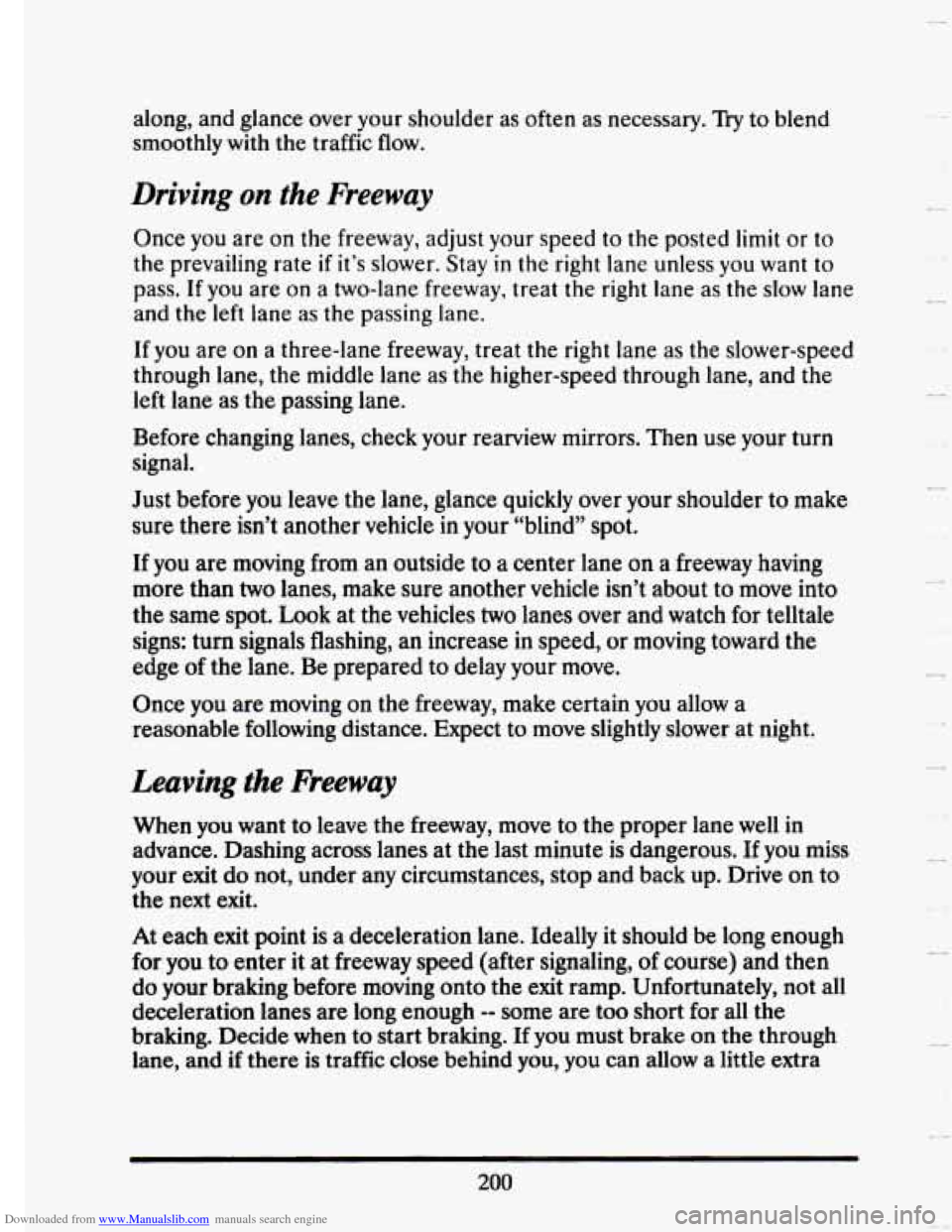
Downloaded from www.Manualslib.com manuals search engine along, and glance over your shoulder as often as necessary. Try to blend
smoothly
with the traffic flow.
Driving on the Freeway
Once you are on the freeway, adjust your speed to the posted limit or to
the prevailing rate
if it’s slower. Stay in the right lane unless you want to
pass.
If you are on a two-lane freeway, treat the right lane as the slow lane
and the left lane as the passing lane.
If you are on a three-lane freeway, treat the right lane as the slower-speed
through lane, the middle lane as the higher-speed through lane,\
and the left
lane as the passing lane.
Before changing lanes, check your rearview mirrors. Then use yo\
ur turn
signal.
Just before you leave the lane, glance quickly over your shoulder to make
sure there isn’t another vehicle in your “blind” spot.
If
you are moving from an outside to a center lane on a freeway having
more than
two lanes, make sure another vehicle isn’t about to move into
the same spot.
Look at the vehicles two lanes over and watch for telltale
signs: turn signals flashing, an increase
in speed, or moving toward the
edge
of the lane. Be prepared to delay your move.
Once you are moving on the freeway, make certain you allow a
reasonable following distance. Expect to move slightly slower at night.
Leaving the Freeway
When you want to leave the freeway, move to the proper lane well in
advance. Dashing across lanes at the last minute is dangerous.
If you miss
your exit do not, under any circumstances, stop and back up. Drive on to
the next exit.
At each exit point is a deceleration lane. Ideally it should \
be long enough
for you to enter it at freeway speed (after signaling, of course) and then
do your braking before moving onto the exit ramp. Unfortunately, not all
deceleration lanes are long enough
-- some are too short for all the
braking. Decide when to start braking.
If you must brake on the through
lane, and
if there is traffic close behind you, you can allow a little extra
200
Page 215 of 407
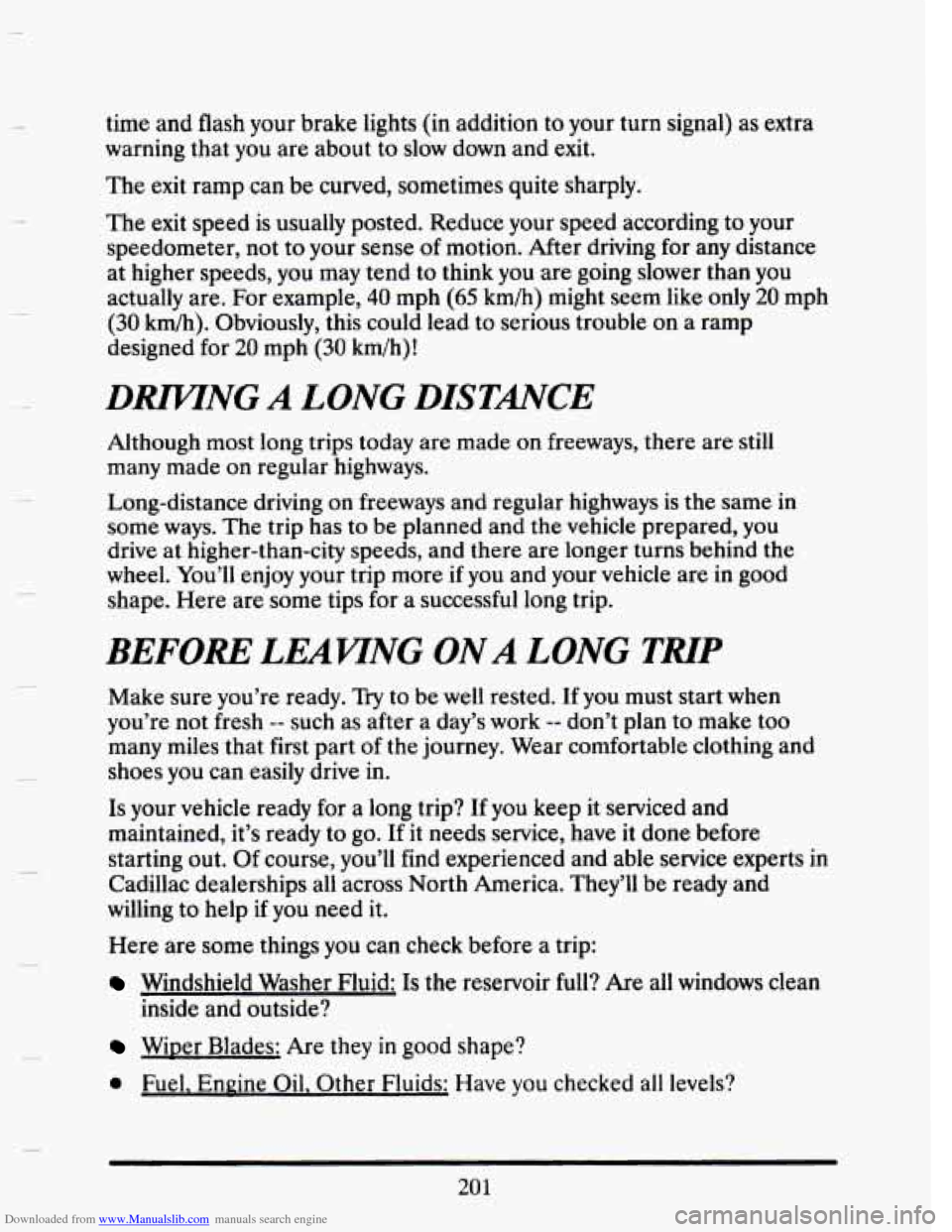
Downloaded from www.Manualslib.com manuals search engine time and flash your brake lights (in addition to your turn signal) as extra
warning that you are about to slow down and exit.
The exit ramp can be curved, sometimes quite sharply.
The exit speed is usually posted. Reduce your speed according
to your
speedometer, not to your sense
of motion. After driving for any distance
at higher speeds, you may tend to think you are going slower than you
actually are. For example,
40 mph (65 km/h) might seem like only 20 mph
(30 km/h). Obviously, this could lead to serious trouble on a ramp
designed for
20 mph (30 km/h)!
DMNG A LONG DISTANCE
Although most long trips today are made on freeways, there are still
many made
on regular highways.
Long-distance driving on freeways and regular highways is the same
in
some ways. The trip has to be planned and the vehicle prepared, you
drive at higher-than-city speeds, and there are longer turns behind
the
wheel. You’ll enjoy your trip more if you and your vehicle are in good
shape. Here are some tips for a successful long trip.
BEFORE LEAWNG ONA LONG THP
Make sure you’re ready. Try to be well rested. If you must start when
you’re not fresh
-- such as after a day’s work -- don’t plan to make too
many miles that first part of
the journey. Wear comfortable clothing and
shoes
you can easily drive in.
Is your vehicle ready for a long trip? If you keep it serviced and
maintained, it’s ready to
go. If it needs service, have it done before
starting out. Of course, you’ll find experienced and able service experts
in
Cadillac dealerships all across North America. They’ll be ready and
willing to help
if you need it.
Here are some things
you can check before a trip:
Windshield Washer Fluid: Is the reservoir full? Are all windows clean
inside and outside?
Wiper Blades: Are they in good shape?
0 Fuel. Enpine Oil. Other Fluids: Have you checked all levels?
201
Page 216 of 407
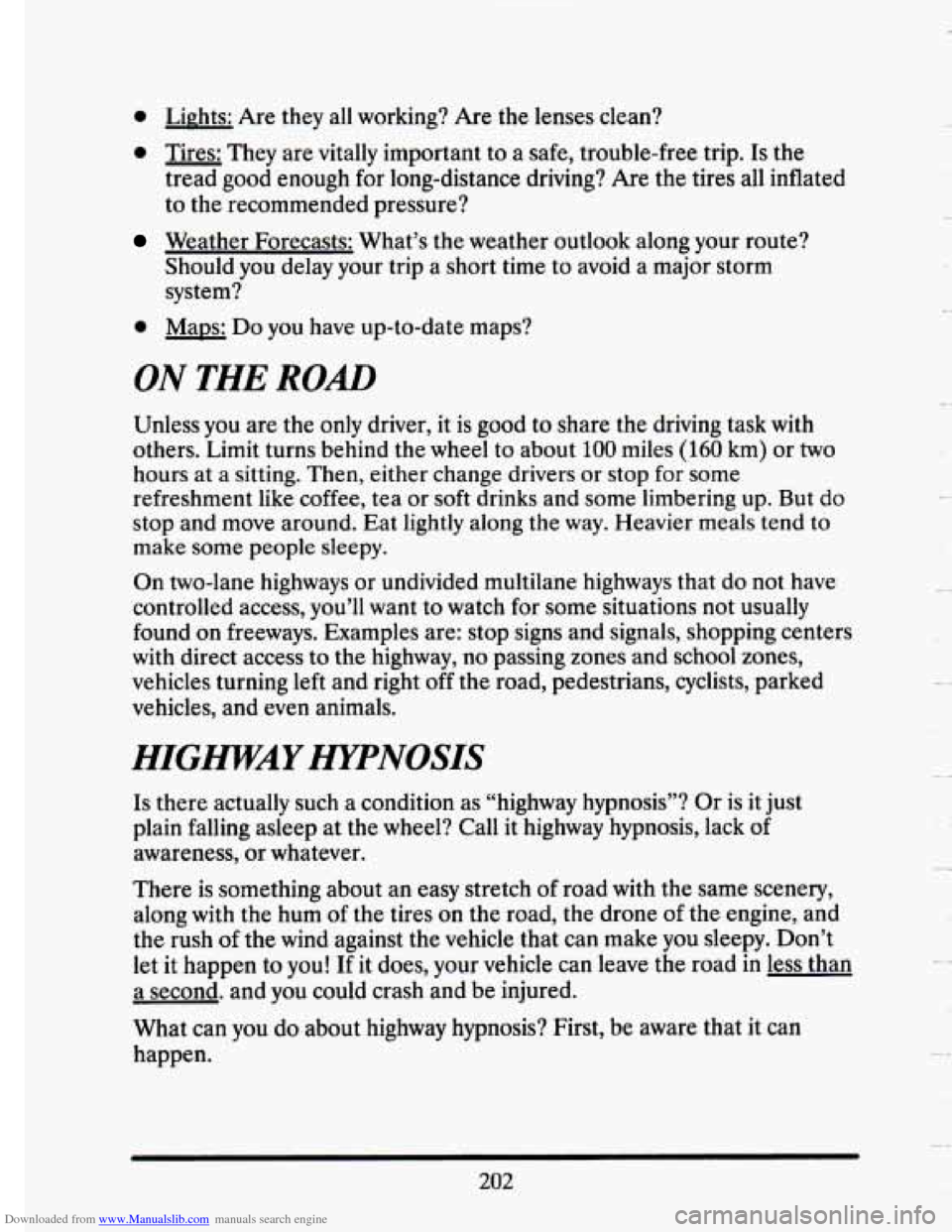
Downloaded from www.Manualslib.com manuals search engine 0 Lights: Are they all working? Are the lenses clean?
0 Tires: They are vitally important to a safe, trouble-free trip. Is the
tread good enough for long-distance driving? Are the tires all inflated
to the recommended pressure?
Weather Forecasts: What’s the weather outlook along your route?
Should you delay your trip a short time to avoid a major storm
system?
0 Maps: Do you have up-to-date maps?
ON THE ROAD
Unless you are the only driver, it is good to share the driving task with
others. Limit turns behind the wheel
to about 100 miles (160 km) or two
hours at
a sitting. Then, either change drivers or stop for some
refreshment like coffee, tea or soft drinks and some limbering up. But
do
stop and move around. Eat lightly along the way. Heavier meals tend to
make some people sleepy.
On two-lane highways or
undivided multilane highways that do not have
controlled access, you’ll want to watch for some situations not usually
found
on freeways. Examples are: stop signs and signals, shopping centers
with direct access
to the highway, no passing zones and school zones,
vehicles turning left and right off the road, pedestrians, cyclists, parked
vehicles, and
even animals.
I
HIGWAY HypNosIS
Is there actually such a condition as “highway hypnosis”? Or is it just
plain falling asleep at the wheel? Call it highway hypnosis, lack of
awareness, or whatever.
There is something about an easy stretch
of road with the same scenery,
along with the hum
of the tires on the road, the drone of the engine, and
the rush
of the wind against the vehicle that can make you sleepy. Don’t
let it happen
to you! If it does, your vehicle can leave the road in less than
a second. and you could crash and be injured.
What can you do about highway hypnosis? First, be aware that it can
happen.
202
-*
Page 231 of 407
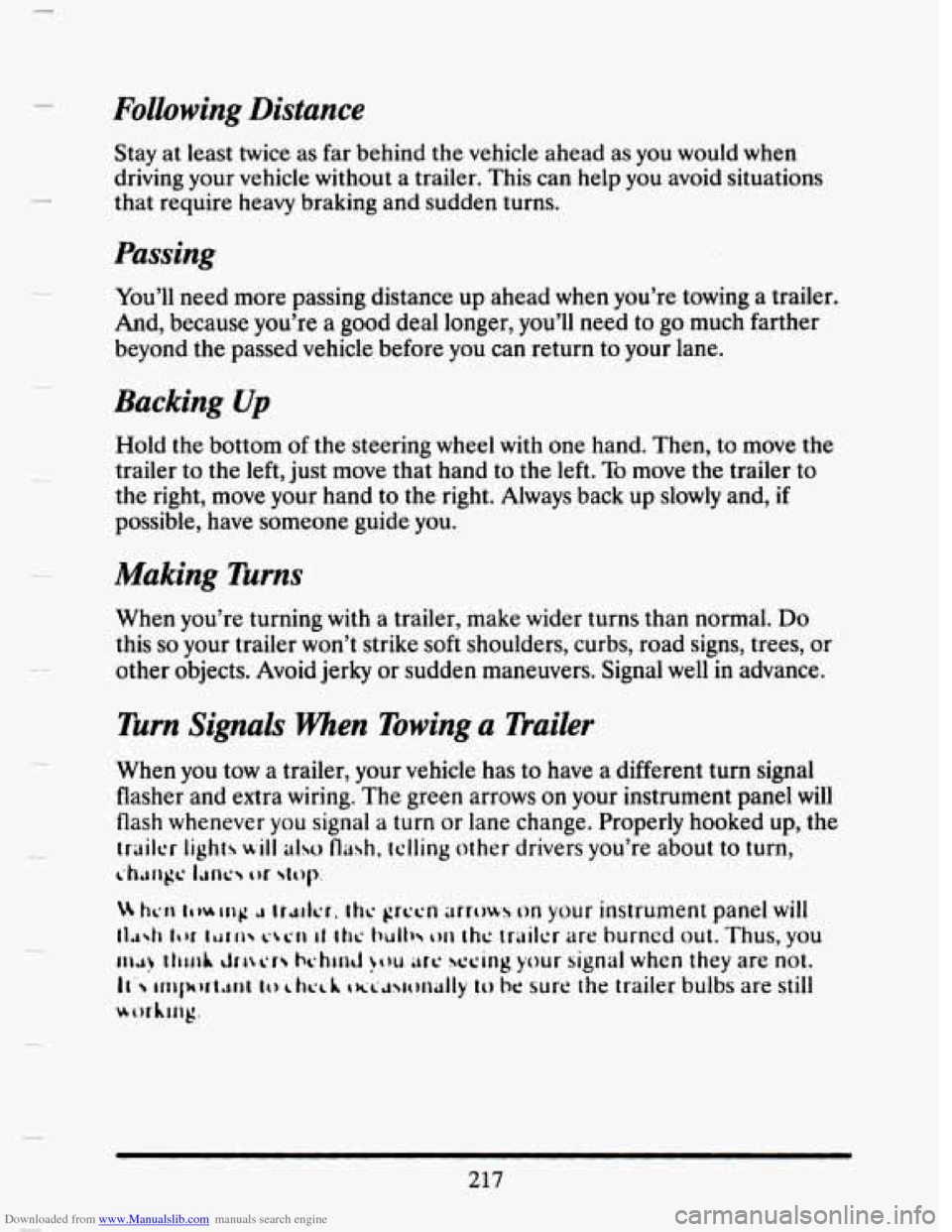
Downloaded from www.Manualslib.com manuals search engine Following Distance
Stay at least twice as far behind the vehicle ahead as you would when
driving your vehicle without a trailer. This can help you avoid situations
that require heavy braking and sudden turns.
Passing
You’ll need more passing distance up ahead when you’re towing a trailer.
And, because you’re
a good deal longer, you’ll need to go much farther
beyond the passed vehicle before you can return to your lane.
Backing Up
Hold the bottom of the steering wheel with one hand. Then, to move the
trailer to the
left, just move that hand to the left. To move the trailer to
the right, move your hand to the right. Always back up slowly and, if
possible, have someone guide you.
Making Turns
When you’re turning with a trailer, make wider turns than normal. Do
this so your trailer won’t strike soft shoulders, curbs, road signs, trees, or
other objects. Avoid jerky or sudden maneuvers. Signal
well in advance.
Turn Signals When Towing a Trailer
When you tow a trailer, your vehicle has to have a different turn signal
flasher and extra wiring.
The green arrows on your instrument panel will
flash whenever you signal a turn or lane change. Properly hooked up, the
trailer lights will dso flash, telling other drivers you’re about to turn,
L.h;lrrgc I;rnc tu ~t~p.
14 IICII IWIII~ Ir.dcr. Itlc grccn arrows on your instrument panel will
tl~4l (tu ILJI~ L-~L-II 11 Ihc twlh thc trailer are burned out. Thus, you
ILA! ItllllA clrr\cr hchlnd >t)u arc swing your signal when they are not.
II’ mpwt,mt 10 L hcc.h txc~w)~~~lly IO be sure the trailer bulbs are still
worhmg.
217
Page 235 of 407
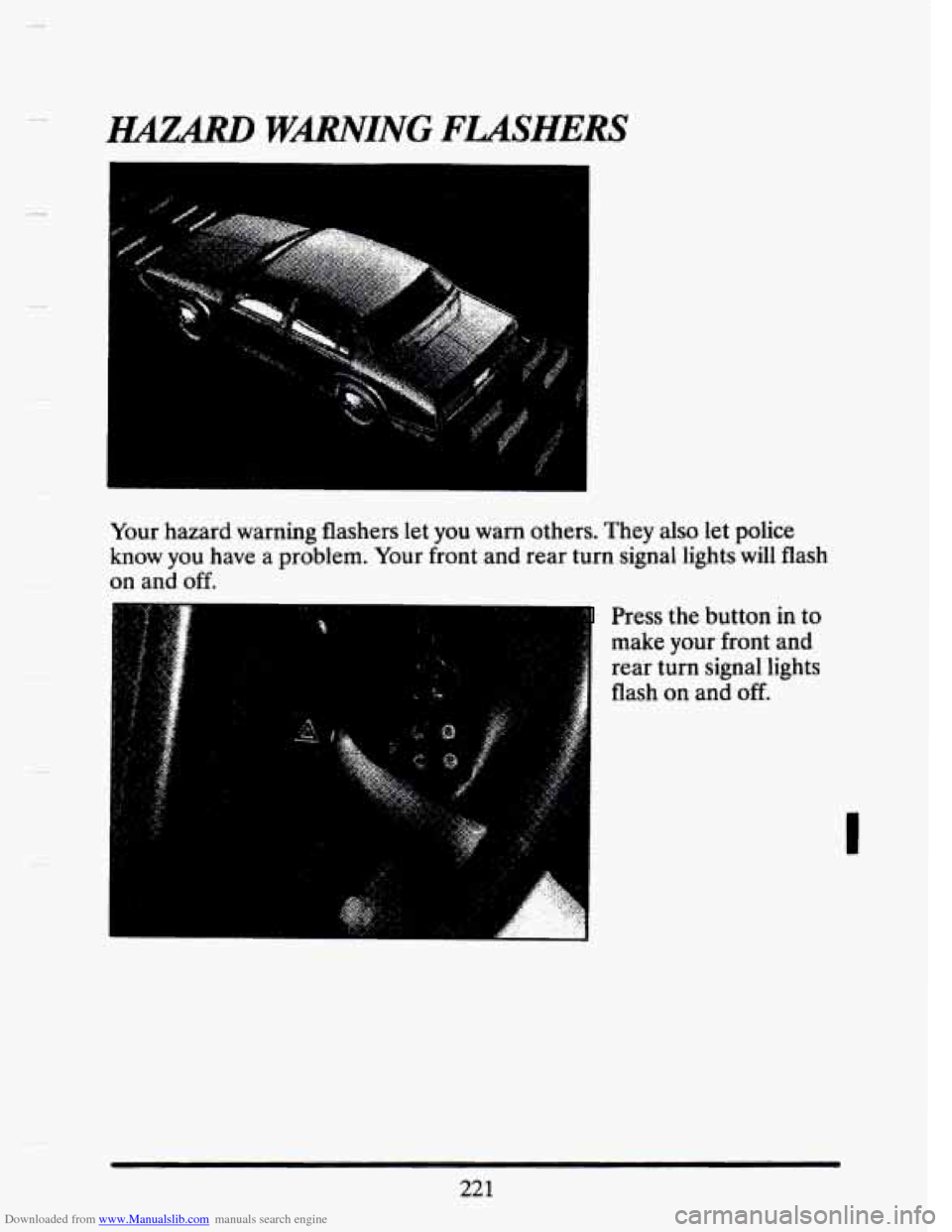
Downloaded from www.Manualslib.com manuals search engine c
c
lyAZARD WARNING FLASHERS
Your hazard warning flashers let you warn others. They also let police
know you have a problem. Your front and rear turn signal lights will flash
on and off.
- 3. .,., Press the button in to
make your front and
rear turn signal lights
flash on and
off.
221
Page 236 of 407

Downloaded from www.Manualslib.com manuals search engine The light on your
instrument panel
will
flash indicating that
the hazard warning
flashers are on.
Your hazard warning flashers work no matter what position your key is in,
and even if the key isn't in.
To turn off the
flashers, pull out on
the collar.
When the hazard warning flashers are
on, your turn signals won't work.
OTHER WNING DE'VICES
If you carry reflective triangles, you can set one up at the side of the road
about
300 feet (100 m) behind your vehicle.
222
Page 343 of 407
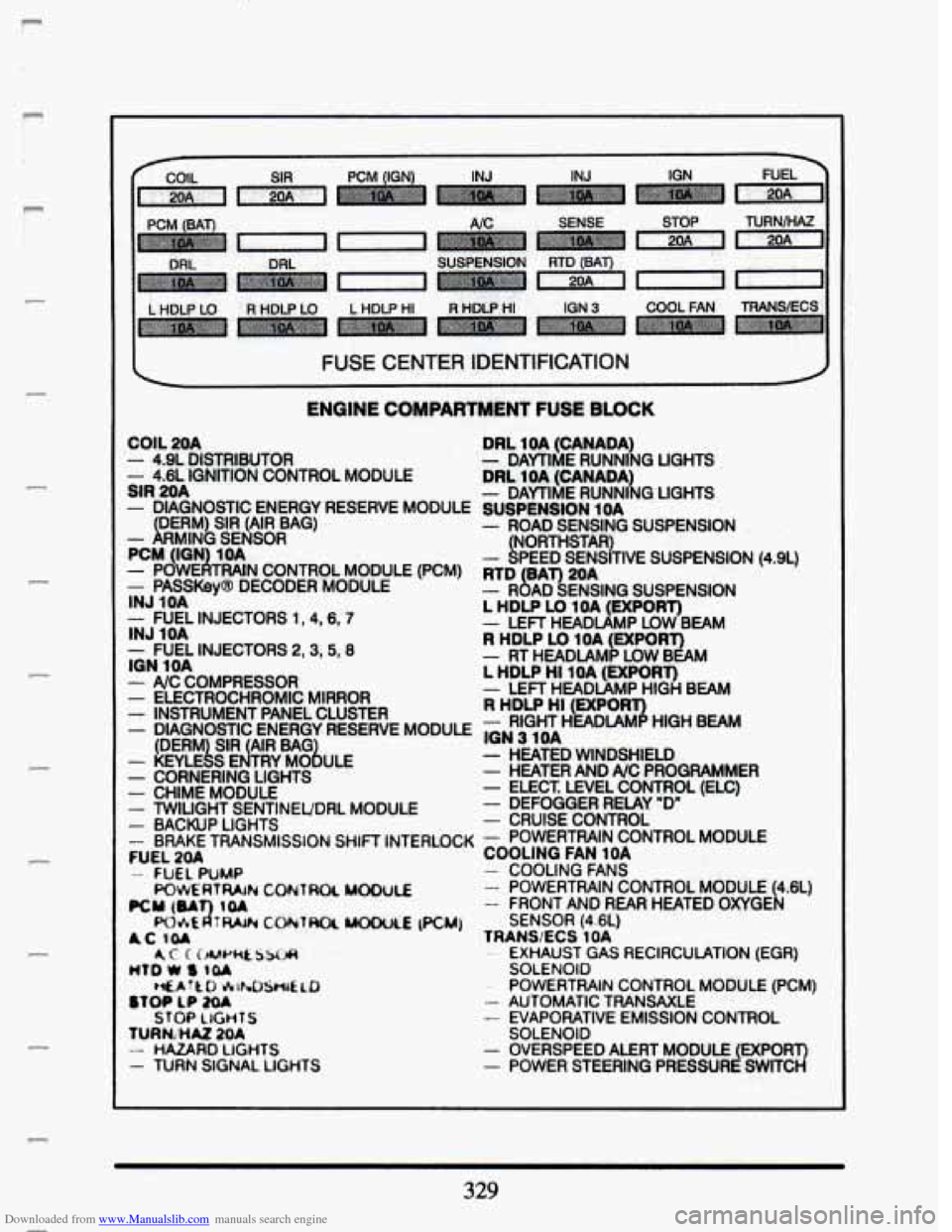
Downloaded from www.Manualslib.com manuals search engine c
P
___.__ HDIP Lo HDLP HI R H'C HI IGN 3 COOL FAN TRANSECS
i I
I FUSE CENTER IDENTIFICATION J
ENGINE COMPARTMENT FUSE BLOCK
COIL 20A - 4.9L DISTRIBUTOR - 4.6L IGNtTION CONTROL MODULE SIR 2OA
- DIAGNOSTIC ENERGY RESERVE - - - - - - -
LF4 DERM) SIR (AIR BAG) - MlNG SENSOR
PCM (IO 1.OA - POWE Y TRAIN CONTROL MODUL
INJ IOA - PASSKeyS DECODER MODULE MODULE
.E (PCM)
--FUEL INJECTORS 1,4,6,7 INJ 1OA - FUEL INJECTORS 2,3,5,8 ION 1OA - A/C COMPRESSOR - ELECTROCHROMIC MIRROR - INSTRUMENT PANEL CLUSTER - DIAGNOSTIC ENERGY RESERVE MODULE
- KEYLE &Pi S E TRY MO b ULE - CORNERING LIGHTS - CHIME MODULE - TWILIGHT SENTINEUDRL MODULE - BACKUP LIGHTS - BRAKE TRANSMISSION SHIFT INTERLOCK
- FUEL PUMP
(DERM SIR AIR BAG
FUEL
20A
PCU(&A IOA
AC IOI
MID W 8 101
$TOP LP ;Ku
fURNiHA2 20A
FQWERTWN CONTROL MOWlE
MI&€ a 7RAIFI CONTRO( uOMKE (PCM)
AC CCEUYellS3uA
HfArtO &NISH&AO
STOP LIGHTS
- HAZARD LIGHTS - TURN SIGNAL LIGHTS
DRL 1OA (CANADA)
DRL
10A (CANADA)
SUSPENSION 1OA
- DAYTIME RUNNING LIGHTS
- DAYTIME RUNNING LIGHTS
- ROAD SENSING SUSPENSION
- LNORTHSTW PEED SENSITIVE SUSPENSION (4.9L)
- R 6 AD SENSING SUSPENSION
- LEFT HEADIAMP LOW BEAM
- RT HEADLAMP LOW BEAM
- LEFT HEADIAMP HIGH BEAM
- RIGHT HEADIAMP HIGH BEAM
- HEATED WINDSHIELD - HEATER AND A/C PROGRAMMER
- ELECT. LEVEL CONTROL (ELC) - DEFOGGER RELAY "D"
- CRUISE CONTROL
- POWERTRAIN CONTROL MODULE
- COOLING FANS
- POWERTRAIN CONTROL MODULE 4.6L)
- FRONT AND REAR HEATED OXYGE L
RTD BAT) 20A
L HDLP LO 1OA (EXPORT)
R HDLP LO 1OA (EXPORT)
L HDLP HI 1OA (EXPORT)
R HDLP HI (EXPORT)
ION 3 1OA
COOLING FAN 1OA
SENSOR (4.6L) TRANSIECS 1 OA
SOLENOID -- EXHAUST GAS RECIRCULATION (EGR)
- POWERTRAIN CONTROL MODULE (PCM) - AUTOMATIC TRANSAXLE - EVAPORATIVE EMISSION CONTROL
- OVERSPEED ALERT MODULE (EXPOR
- POWER STEERING PRESSURE SWITC 3
SOLENOID
329
I
F
Page 346 of 407
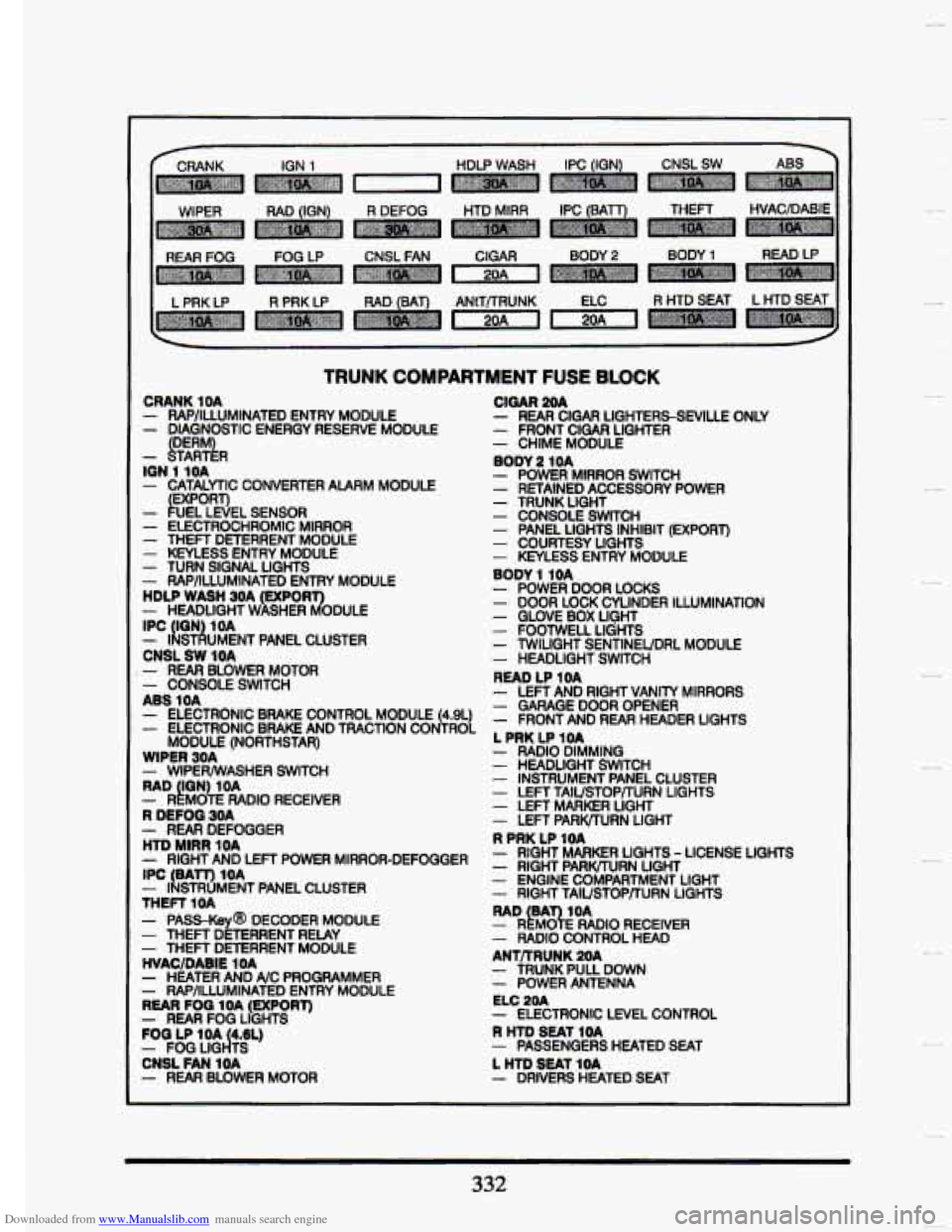
Downloaded from www.Manualslib.com manuals search engine L PRK LP R PRK LP R HTD SEAT L HTD S
TRUNK COMPARTMENT FUSE BLOCK
CRANK 1OA - RAPIILLUMINATED ENTRY MODULE - DIAGNOSTIC ENERGY RESERVE MODULE
- L?.FTLR
IGN 3 IOA-. - CATALYTIC CONVERTER ALARM MODULE
- PPORT) UEL LEVEL SENSOR - ELECTROCHROMIC MIRROR - THEFT DETERRENT MODULE - KEYLESS ENTRY MODULE - TURN SIGNAL LIGHTS - RAP/ILLUMINATED ENTRY MODULE
- HEADLIGHTW k3 SHEA ODULE HDLP WASH 3OA EXPOR
IPC IGN 1OA
CNSL SW 1OA
- ILsdUMENT PANEL CLUSTER
. - REAR BLOWER MOTOR - CONSOLE SWITCH
- ELECTRONIC BRAKE CONTROL MODULE 4.9L) ABS 10A
- EECmONlC BRAKE AND mcmN CON(tROL
MODULE (NORTHSTAR)
WIPER 30A
RAD IGN) 1OA
R DEFOG 30A - REAR DEFOGGER HtD MIRR 1OA - RIGHT AND LEFT POWER MIRROR-DEFOGGER IPC BATT) 1OA
THEFT 1
OA
- WIPERWASHER SWITCH
- RLMOTE RADIO RECEIVER
- IhMENT PANEL CLUSTER
- PASS-ky@ DECODER MODULE - THEFT DETERRENT RELAY - THEFT DETERRENT MODULE HVACIDABIE 1 OA - HEATER AND NC PROGRAMMER - RAPALLUMINATED ENTRY MODULE REAR FOG 1 OA (EXPORT) - REAR FOG LIGHTS FOG LP 10A 4.6L)
CNSL FAN 1OA - FOG LIGk
- REAR BLOWER MOTOR
CIGAR 2OA - REAR CIGAR LIGHTERSSNILLE - FRONT CIGAR LIGHTER - CHIME MODULE
- POWER MIRROR SWITCH - RETAINED ACCESSORY POWER - TRUNK LIGHT - CONSOLE SWITCH - PANEL LIGHTS INHlBtT (EXPORT) - COURTESY UQHTS - KEYLESS ENTRY MODULE
BODY 2 1OA
ONLY
BODY 1 1OA - POWER DOOR LOCKS - DOOR LOCK CYLINDER ILLUMINATION - GLOVE BOX LIGHT - FOOTWELL LIGHTS - TWILIGHT SENTINEUDRL MODULE - HEADLIGHT SWITCH
- LEFT AND RIGHT VANITY MIRRORS - GARAGE DOOR OPENER - FRONT AND REAR HEADER LIGHTS
- RADIO DIMMING - HEADLIGHT SWITCH - INSTRUMENT PANEL CLUSTER - LEFT TAIUSTOPflURN LIGHTS - LEFT MARKER LIGHT - LEFT PARKITURN LIGHT
READ LP 1OA
L PRK LP 1OA
R PRK LP 1OA - RIGHT MARKER LIGHTS - LICENSE LIQI - RIGHT PARWTURN LIGHT - ENGINE COMPARTMENT LIGHT - RIGHT TAIUSTOP/TURN LIGHTS ITS
- REM& RADIO RECEIVER RAD EA 1OA
- RADIO CONTROL HEAD
ANTRRUNK
POA - TRUNK PULL DOWN - POWER ANTENNA
ELC
20A - ELECTRONIC LEVEL CONTROL
R HTD SEAT 1OA - PASSENGERS HEATED SEAT
L HTD SEAT 1OA - DRIVERS HEATED SEAT
332
I